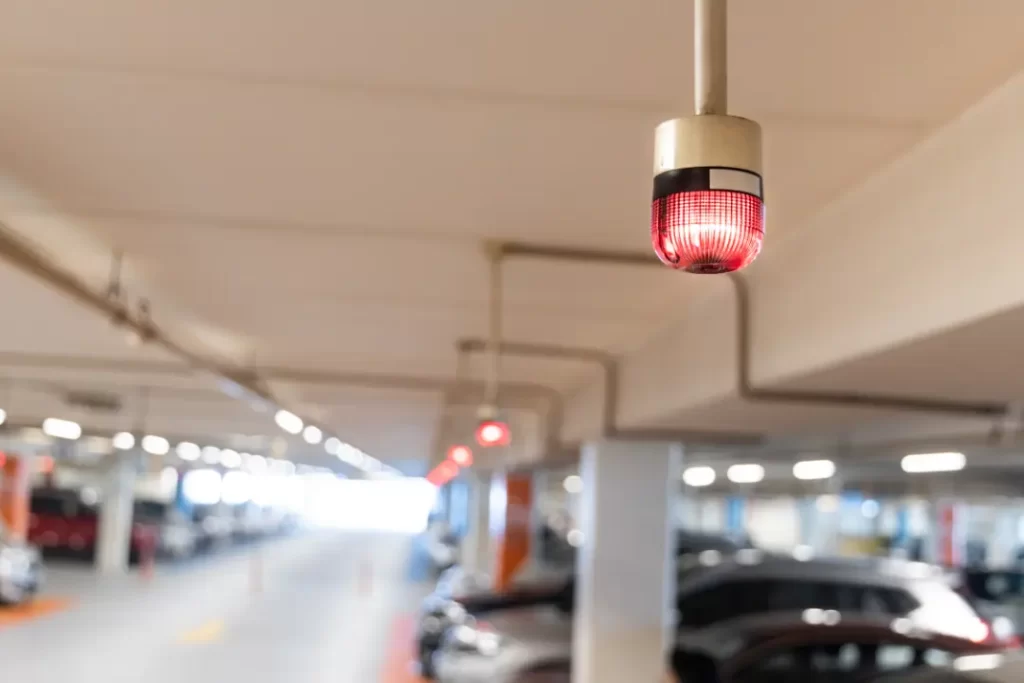What are the parking lights on a car? Parking lights, or sidelights, are small lights on a car meant to boost visibility when parked in dim conditions. In this article, we’ll discuss their purpose, how to activate them, and when to use them.
Key Takeaways
- Parking lights, also known as sidelights, are designed to make a parked car visible to other drivers in low-light conditions and are legally required on roads with speed limits exceeding 30 mph.
- To activate parking lights, use the controls typically found beside the steering wheel in most modern cars; these lights must be manually set as automatic headlights do not control them.
- Functional parking lights are essential for passing MOT tests and maintaining the vehicle’s resale value, as faulty lights can indicate poor maintenance and lead to test failures.
Understanding Parking Lights
Parking lights, also called sidelights, are positioned at the front of the car. They serve as a marker for the parked vehicle. Their primary purpose is to make your car visible to other drivers when parked in low-light conditions or on roads with higher speed limits. These lights are not designed for driving but enhance visibility when your vehicle is stationary.
Typically, parking lights:
- are amber in colour
- are less bright than regular headlights
- emit just enough light to alert other drivers without overwhelming them
- ensure that your vehicle meets all visibility requirements when you are parked on the side of the road
Modern cars are universally equipped with various car lights, including brakes and hazard lights.
Whether you own an older model or a brand-new vehicle, parking lights are a crucial feature for safety and compliance. Understanding their function and appearance, usually a warm yellowish glow for halogen bulbs or a brighter, whiter tone for LEDs, is the first step in using them correctly.

How to Turn On Parking Lights
Turning on your parking lights is straightforward, but it’s essential to know where to find the controls. In most modern cars, the parking light control is typically located beside the steering wheel, either as a small dial or a switch. This placement makes it easy to access without taking your eyes off the road for too long.
You usually need to move the indicator stick or switch the small dial by the steering wheel to activate the parking lights. In some older car models, you might have to turn the lighting column stalk or a selector knob on the dashboard to a position between off and dipped headlights. This manual activation is crucial because automatic headlights do not control parking lights.
Remember, parking lights need to be set manually. Unlike the convenience of automatic headlights, which adjust based on lighting conditions, parking lights require your intervention to ensure they function correctly when needed.
When Should You Use Parking Lights?
Parking lights are essential for making your car visible when it’s not dark enough for the main lights but still dim enough for other drivers to be aware of your vehicle. A common scenario for using parking lights is when you’re parked on a road at night with a speed limit of over 30 mph. Using parking lights ensures that other drivers can see your vehicle from a distance, reducing the risk of accidents.
The Highway Code stipulates that parking lights must be used when your vehicle is parked on a road or in a lay-by with a speed limit exceeding 30 mph. This requirement aims to enhance visibility and safety for other road users. This law is particularly relevant in residential areas with higher speed limits, where visibility is crucial for safety. Additionally, if you’re parked on the road in foggy conditions, leaving your parking lights on, regardless of the speed limit, is advisable.
Using parking lights correctly not only helps adhere to legal requirements but also significantly enhances your safety and that of other road users. It’s a simple yet effective way to ensure your parked vehicle is visible in various conditions.
Differences Between Parking Lights and Headlights
Parking lights and headlights serve different purposes, and it’s vital to understand these distinctions to use them properly. Parking lights, also known as sidelights, are designed to make your car visible to other road users when parked in low-light conditions. They are not intended for driving and should never be used as a substitute for headlights while on the move.
On the other hand, headlights are essential for driving in the dark or during poor weather conditions. They include dipped-beam headlights, brighter than parking lights but not as intense as full-beam headlights. Dipped beams are angled downwards to illuminate the road without dazzling other drivers. Full-beam headlights, the brightest of all, are used on unlit roads but must be turned off when encountering oncoming traffic.
Understanding these differences ensures that you use each type of light appropriately, enhancing your safety and compliance with road vehicle lighting regulations.
Parking Lights Symbol
Recognising the parking lights symbol on your vehicle’s dashboard is crucial for ensuring you can activate these lights when needed. The symbol typically consists of two semicircles facing opposite directions, each surrounded by three short lines representing light beams. This distinct icon helps you quickly identify the parking light control.
This symbol is on the light control switches or dials in most modern cars. Familiarising yourself with it ensures you can easily locate and activate your parking lights, especially in situations where visibility is crucial.
Correctly identifying and using the parking lights symbol is a small but vital part of car maintenance and safety. It ensures you are prepared to enhance your vehicle’s visibility whenever necessary.

Do Parking Lights Drain Your Battery?
A common concern among car owners is whether leaving parking lights on will drain the battery. Fortunately, parking lights are designed to consume very minimal energy. They use low-wattage bulbs that provide sufficient light without significantly damaging the car’s battery.
As long as your car’s battery is in good health, leaving the parking lights on overnight should not cause any problems. However, ensuring your battery is regularly checked and maintained to avoid any unexpected issues is always a good practice.
Are Parking Lights Legally Required?
Understanding the legal requirements for parking lights is essential for all drivers. Section 249 of the Highway Code stipulates that vehicles parked on a road or lay-by with a speed limit greater than 30 mph should have their parking lights displayed. This requirement ensures safety and visibility for other road users. This regulation ensures that parked vehicles are visible to other road users, reducing the risk of accidents.
On roads with a speed limit of 30 mph or under, parking lights are unnecessary if the vehicle is parked at least 10 meters away from any junction, close to the curb, and facing the traffic flow. However, parking lights should be left on in foggy conditions regardless of the speed limit.
All cars driven on UK roads must have a full set of working sidelights, as it is a legal requirement. These regulations help ensure the safety of drivers and other road users. If the front or rear sidelights or number plate bulbs are faulty, the MoT test will result in failure. It is important to ensure that these lights are in proper working condition. Non-compliance with these regulations can result in fines ranging between £35 and £75.
Ensuring your display parking lights are functional and used correctly is not only about complying with the law but also about maintaining safety on the roads when you leave parking lights on.
Common Issues with Parking Lights
Parking lights, like any other car component, can encounter issues. A common problem is a faulty switch that remains stuck in the ‘on’ position, causing the lights to stay on even when the car is off. Another issue can be a relay stuck in the closed position, which keeps the lights illuminated.
Electrical problems in the wiring can also cause parking lights to stay on when they shouldn’t. In some vehicles, the parking light on the signalled side will remain lit if the car is turned off with the turn signal switch left on.
If you encounter persistent issues with your parking lights, it is advisable to consult a qualified mechanic. They can diagnose and fix the problem, ensuring your lights function correctly and your vehicle remains safe.
The Impact of Faulty Parking Lights on MOT and Resale Value
Faulty parking lights can significantly affect your vehicle’s MOT and resale value. All lights on a vehicle, including the parking lights, must be in good working order for it to pass an MOT. Ensuring that your parking lights are functioning correctly is crucial for the vehicle’s safety and visibility on the road. Your vehicle will likely fail its MOT test if they are not working properly.
In addition to MOT issues, broken parking lights can negatively affect your car’s resale value. Potential buyers may view faulty lights as a sign of poor maintenance, reducing their willingness to pay a higher price. Therefore, fixing any issues with your parking lights before putting your car up for sale is always a good idea.
Maintaining functional parking lights is a small investment that can pay off in the long run by ensuring your vehicle passes MOT tests and retains its value.

Parking Lights in Modern Cars
Modern cars have seen significant advancements in lighting technology, including parking lights. These lights are often integrated with adaptive front-lighting systems that adjust the direction and intensity based on vehicle speed, road conditions, and steering angle. This integration ensures optimal visibility and safety.
Automotive lighting control systems in modern cars have evolved to manage various lighting modes through user interfaces like dashboard switches, touch screens, and voice commands. These advancements make it easier for drivers to control their parking lights and other lighting functions.
Modern lighting systems also use advanced communication protocols such as CAN (Controller Area Network) or LIN (Local Interconnect Network) for better intra-vehicle communication. This ensures that all lighting components work seamlessly together, enhancing the vehicle’s overall functionality and safety.
Summary
Parking lights may seem like a minor feature, but they play a crucial role in vehicle safety and compliance with road regulations. They ensure your car is visible in low-light conditions and are legally required in specific scenarios. Understanding how to use them correctly can prevent accidents and legal penalties.
At Sovereign Motor Engineers, we emphasise the importance of every vehicle component, including parking lights. Ensuring they are in good working order keeps you safe and maintains your vehicle’s value. Always remember to check and use your parking lights appropriately to stay safe on the roads.
Frequently Asked Questions
What are parking lights used for?
Parking lights are used to make your car visible to other drivers when it is parked in low-light conditions or on roads with higher speed limits. They help prevent accidents by increasing visibility.
How do I turn on my parking lights?
To turn on your parking lights, look for the control beside the steering wheel and use the indicator stick or small dial to activate them.
Do parking lights drain the car battery?
No, parking lights consume minimal energy and should not drain a healthy car battery when left on overnight.
Are parking lights legally required in the UK?
Yes, parking lights are legally required when parked on roads with speed limits over 30 mph and in foggy conditions. Make sure to use them in these situations to comply with the law.
What are common issues with parking lights?
Faulty switches, stuck relays, and electrical wiring problems are common issues with parking lights. If these problems persist, it’s best to consult a mechanic for assistance.


